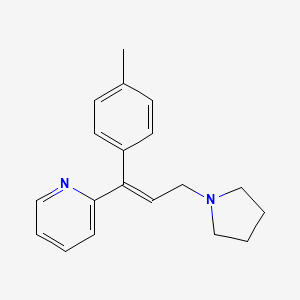Attribution Statement: LactMed is a registered trademark of the U.S. Department of Health and Human Services.
NCBI Bookshelf. A service of the National Library of Medicine, National Institutes of Health.
Drugs and Lactation Database (LactMed®) [Internet]. Bethesda (MD): National Institute of Child Health and Human Development; 2006-.
CASRN: 486-12-4

Drug Levels and Effects
Summary of Use during Lactation
Small, occasional doses of triprolidine would not be expected to cause any adverse effects in breastfed infants. Larger doses or more prolonged use may cause effects in the infant or decrease the milk supply, particularly in combination with a sympathomimetic such as pseudoephedrine or before lactation is well established. The nonsedating antihistamines are preferred alternatives.
Drug Levels
Maternal Levels. Single doses of triprolidine of 2.5 mg produced peak milk levels of about 7 to 9 mcg/L at about 1 to 2 hours after the dose in 3 women. Milk levels fell with half-lives ranging from 2.8 to 18.9 hours among the 3 mothers. The dose a fully breastfed infant would receive was calculated to be 0.6 to 0.2% of the mother's weight-adjusted dosage.[1]
Infant Levels. Relevant published information was not found as of the revision date.
Effects in Breastfed Infants
In one telephone follow-up study, mothers reported irritability and colicky symptoms 10% of infants exposed to various antihistamines and drowsiness was reported in 1.6% of infants. None of the reactions required medical attention and none of the mothers were taking triprolidine.[2]
In one study, no infant side effects were reported in three infants whose mothers took one dose of triprolidine 2.5 mg and pseudoephedrine 60 mg.[1]
Effects on Lactation and Breastmilk
Antihistamines in relatively high doses given by injection can decrease basal serum prolactin in nonlactating women and in early postpartum women.[3,4] However, suckling-induced prolactin secretion is not affected by antihistamine pretreatment of postpartum mothers.[3] Whether lower oral doses of antihistamines have the same effect on serum prolactin or whether the effects on prolactin have any consequences on breastfeeding success have not been studied. The prolactin level in a mother with established lactation may not affect her ability to breastfeed.
Alternate Drugs to Consider
References
- 1.
- Findlay JW, Butz RF, Sailstad JM, et al. Pseudoephedrine and triprolidine in plasma and breast milk of nursing mothers. Br J Clin Pharmacol. 1984;18:901–6. [PMC free article: PMC1463694] [PubMed: 6529531]
- 2.
- Ito S, Blajchman A, Stephenson M, et al. Prospective follow-up of adverse reactions in breast-fed infants exposed to maternal medication. Am J Obstet Gynecol. 1993;168:1393–9. [PubMed: 8498418]
- 3.
- Messinis IE, Souvatzoglou A, Fais N, et al. Histamine H1 receptor participation in the control of prolactin secretion in postpartum. J Endocrinol Invest. 1985;8:143–6. [PubMed: 3928731]
- 4.
- Pontiroli AE, De Castro e Silva E, Mazzoleni F, et al. The effect of histamine and H1 and H2 receptors on prolactin and luteinizing hormone release in humans: Sex differences and the role of stress. J Clin Endocrinol Metab. 1981;52:924–8. [PubMed: 7228996]
Substance Identification
Substance Name
Triprolidine
CAS Registry Number
486-12-4
Disclaimer: Information presented in this database is not meant as a substitute for professional judgment. You should consult your healthcare provider for breastfeeding advice related to your particular situation. The U.S. government does not warrant or assume any liability or responsibility for the accuracy or completeness of the information on this Site.
- User and Medical Advice Disclaimer
- Drugs and Lactation Database (LactMed) - Record Format
- LactMed - Database Creation and Peer Review Process
- Fact Sheet. Drugs and Lactation Database (LactMed)
- Drugs and Lactation Database (LactMed) - Glossary
- LactMed Selected References
- Drugs and Lactation Database (LactMed) - About Dietary Supplements
- Breastfeeding Links
- PMCPubMed Central citations
- PubChem SubstanceRelated PubChem Substances
- PubMedLinks to PubMed
- Review Acrivastine.[Drugs and Lactation Database (...]Review Acrivastine.. Drugs and Lactation Database (LactMed®). 2006
- Review Brompheniramine.[Drugs and Lactation Database (...]Review Brompheniramine.. Drugs and Lactation Database (LactMed®). 2006
- Review Phenindamine.[Drugs and Lactation Database (...]Review Phenindamine.. Drugs and Lactation Database (LactMed®). 2006
- Review Dexchlorpheniramine.[Drugs and Lactation Database (...]Review Dexchlorpheniramine.. Drugs and Lactation Database (LactMed®). 2006
- Review Dexbrompheniramine.[Drugs and Lactation Database (...]Review Dexbrompheniramine.. Drugs and Lactation Database (LactMed®). 2006
- Triprolidine - Drugs and Lactation Database (LactMed®)Triprolidine - Drugs and Lactation Database (LactMed®)
Your browsing activity is empty.
Activity recording is turned off.
See more...
